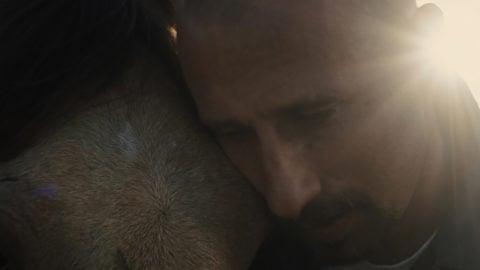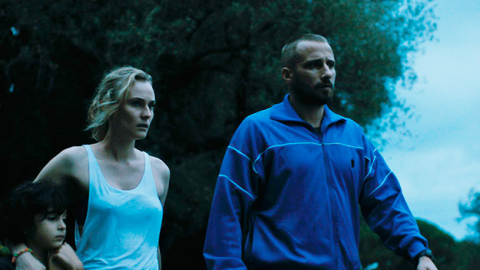Present Tense: Matthias Schoenaerts
Present Tense is a column by Sheila O’Malley that reflects on the intersections of film, literature, art, and culture.
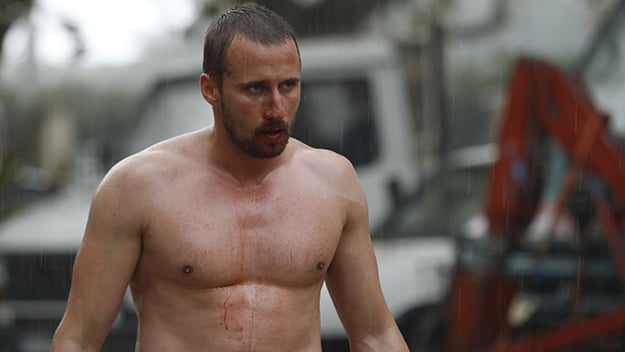
Rust & Bone (Jacques Audiard, 2012)
In a 2012 interview about Jacques Audiard’s Rust and Bone, the interviewer observed of Belgian actor Matthias Schoenaerts that his character’s brutality was “learned behavior,” words more appropriate for a social studies class than an acting performance. Schoenaerts’ reply was illuminating: “I wanted to make him simple and sincere, and very instinctive and intuitive. Everything he does should feel like a reflex. Being tender is a reflex. Being brutal is a reflex. He doesn’t calculate his moves. He’s direct, he’s straight forward, there’s no second thought.” Ali does many careless and cruel things in Rust and Bone, and yet here Schoenaerts was, talking about the character’s “sincerity.” You need to watch Schoenaerts’ work with a close eye; his response shows the depths of his approach.
If you look at Schoenaerts’ work as a whole (and he’s been around for almost 20 years), it becomes clear that one of his sweet spots as an actor is playing muscle-bound men: men fearful of seeming less than a man, trapped in an almost total lack of self-awareness. You could talk about what societal issues conspire to create all this “learned behavior.” Patriarchal attitudes don’t just impact women. But that’s for the classroom and the op-ed page. Schoenaerts often plays blue-collar guys intimidated by and ignored by the white-collar world, the kind of guy people write off with a glance. In watching Schoenaerts—particularly in Bullhead, Rust and Bone, Disorder, and this year’s The Mustang—the critique of society is implicit, not explicit. You get wrapped up in what life is like for these characters. You may recoil at some of the things they do, but Schoenaerts forces us to be with them, listen to them, feel for them. Schoenaerts is drawn to ambiguous characters—the word comes up again and again in his interviews—and he has insight into these men, men who could be tough-guy cliches, but in his hands are fully-realized, three-dimensional characters.
Having insight is different than having a take. Having a take implies distance, standing back from the character in judgment. A take can be a dead-end street. But insight opens into experiential reality, giving the actor a wider space in which to create. Robert De Niro in Taxi Driver didn’t have a take on people like Travis Bickle so much as he had deep insight into how loneliness and isolation can warp a man like Travis (and, by extension, other men like Travis, and, by further extension, all of us). De Niro was prescient in his portrayal of a now-familiar type, the parade of “alienated” white males who become mass shooters, but there is no sense of De Niro standing back to diagnose society or Travis. His immersion was total.
To prove this isn’t merely a Method way of working: consider Ralph Richardson’s not-Method-at-all performance as Dr. Austin Sloper in The Heiress. The character is monstrous in many ways, but he is also a product of his society and its limitations. Richardson’s performance is an intricate psychological masterpiece, utilizing his understanding of Henry James’s book, as well as his understanding of Dr. Sloper’s privileged status and how that status—and, by implication, the society that created it—is rotten to the core. Richardson conveys all of this in his performance. That’s insight.
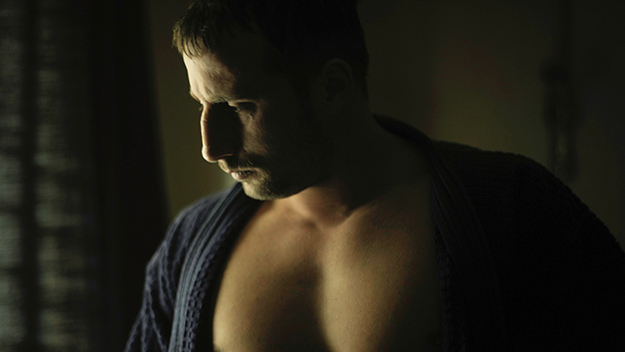
Bullhead (Michael R. Roskam, 2011)
Bullhead, nominated for an Oscar for Best Foreign Film, brought Schoenaerts to a wide audience for the first time. Written and directed by Michaël R. Roskam and developed with Schoenaerts over a 5-year period, Bullhead’s central character is Jacky Vanmarsenille (Schoenaerts), a cattle farmer in the Flemish area of Belgium. Left impotent by a vicious attack in childhood, Jacky bulks up on steroids to compensate. He is a looming giant, his face a dead-eyed wall. Bullhead is a harrowing portrait of a man unable to access masculinity in a meaningful or organic way, and Schoenaerts’ performance deserves to stand toe to toe with other more famous performances in a similar vein (Raging Bull, Taxi Driver, A Streetcar Named Desire, etc.)
One of the most revelatory moments of the film occurs in a nightclub. A well-dressed crowd dances and drinks. Jacky, who never goes to clubs, is acutely self-conscious. He feels over-exposed, as though everyone can tell he’s not a “real man” just by looking at him. Interacting with other people is quite literally unbearable for Jacky. Sex is off the table entirely. Unmoored, out of his element, Jacky stands with a drink, and—just in case anyone looks at him—he grooves around to the music a little bit. But he’s too self-conscious and stops. The moment is so vulnerable and lonely it’s almost unwatchable. Jacky’s world is comfortless. Schoenaerts often plays such men.
The following year came Rust and Bone, co-starring Marion Cotillard. Here, Schoenaerts plays another “brute,” albeit a very different kind. Ali is a drifting ex-boxer, trying to get his career going again, dragging his young son after him. Unlike Jacky, Ali is not at all self-conscious about “being a man.” In fact, Ali isn’t self-conscious about anything. He comes and goes, he does what he wants to do when he wants to do it—even if it inconveniences others. Sex for him is the same as working out, eating, or any other bodily function. This ends up being just what the doctor ordered for Marion Cotillard’s Stéphanie, an educated woman fallen on hard times after being injured on the job (working with orcas at SeaWorld).

Matthias Schoenaerts and Marion Cotillard in Rust and Bone
If Ali had been played as a violent predatory man, Rust and Bone would have been the cliched story of a good woman healing a bad man. Instead, Rust and Bone is about two damaged people who—for mysterious alchemical reasons—find an oasis with one other. Watch Schoenaerts watching Cotillard play with the young son. There’s so much going on in his face it’s impossible to narrow it down to one thing. Watch him lying beneath Cotillard, straining his head up to kiss her, even though she has told him not to kiss her during sex. Schoenaerts said of Ali, “He’s attaching himself to Stéphanie without even knowing it. She gets under his skin and he doesn’t even notice it. Once she’s gone he realizes, ‘Jesus Christ I love this person.’” How do you play a man who doesn’t know himself? How do you portray the first dawning of self-awareness? Watch Schoenaerts in Rust and Bone. Rust and Bone is one of the few films where the words “I love you” sound like the redeeming miracle they actually are.
Alice Winocour’s Disorder is a home invasion thriller told entirely from the perspective of Schoenaerts’ Vincent, a soldier suffering from PTSD and hearing loss. Vincent works as a security guard for Jessie (Diane Kruger), the wife of a wealthy businessman. Peacetime life is no longer possible for Vincent. He lives in a state of hypervigilance, the world coming at him in a confusing hallucination where everything is a threat. When a real threat arrives, Vincent’s skills kick in automatically. In violence, he knows what to do. The performance calls to mind Marcel Proust’s description of war veterans marching by the house in In Search of Lost Time: “They’ve no fear of death left in them; they’re nothing more nor less than madmen … they’re not men anymore, they’re lions.” Winocour’s approach is deeply empathetic to Vincent’s mental struggles, but Schoenaerts’ instincts add subtextual details, drawing us into Vincent’s experience. Vincent watches his buddy flirt with Jessie, and he wants to join in but can’t. Social ease is beyond him. The final moment of the film expands into ambiguous, dreamy territory. Is it real? Or Vincent’s fantasy? The urgency of these questions is a testament to what Schoenaerts has accomplished.
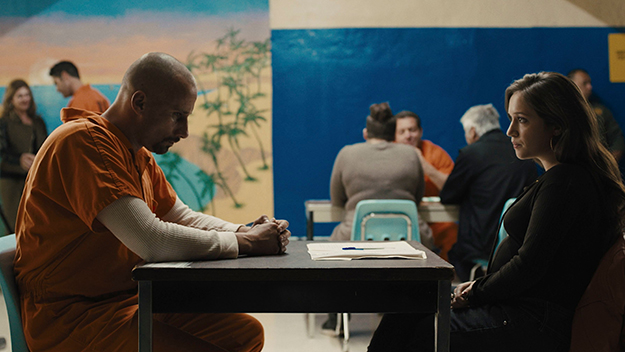
Matthias Schoenaerts and Gideon Adlon in The Mustang (Laure de Clermont-Tonnerre, 2019)
As Roman in The Mustang, directed by Laure de Clermont-Tonnerre, Schoenaerts plays a convict participating in a rehabilitation program where prisoners tame wild mustangs for auction. A limited and volatile man, Roman was convicted for killing someone in a domestic violence dispute. Things shift for him once he starts working with a very wild horse. He has to learn how to control the horse without cruelty. When the horse doesn’t obey him, Roman is hurt, and when Roman is hurt he flies off the handle. There’s only one conduit for all of his emotions. There’s a scene between Roman and his daughter (Gideon Adlon), where Roman’s shame and self-loathing is so overwhelming he can barely allow himself to feel it at all. The experience of his own emotions is so stressful it looks like his skin is literally boiling off his skull. This is what it looks like when men aren’t allowed to feel things, when an entire culture tells 5-year-olds “Boys don’t cry.”
Considering all of this, it’s fascinating to watch Schoenaerts in films like A Bigger Splash or Far From the Madding Crowd. He leaves behind tormented masculinity to explore other things, and does so with great ease. In Far From the Madding Crowd, Schoenaerts is an extremely appealing romantic leading man. He projects a gentle kindness, even though Gabriel doesn’t say all that much. Schoenaerts’ characters rarely do. Schoenaerts said once that the first thing he does with a new script was cut as many of his lines as possible: “What can I play without having to say it? If I can do it without saying it, then why say it?” John Wayne. Gary Cooper, Humphrey Bogart … all would sit down and cut down their lines because they knew it was better to express a moment with a gesture or a look. Remember that the next time someone says the number of lines a character has is in any way relevant to the character’s importance.
Schoenaerts can say more with a half-smile, an intake of breath, his body’s movements, than any dialogue could ever accomplish. He works a lot (there’s the new Malick and the new Soderbergh to look forward to), but better than that, he works smart. He chooses well. He asks the right questions and cares about the right things. His insights are invaluable.
Sheila O’Malley is a regular film critic for Rogerebert.com and other outlets including The Criterion Collection. Her blog is The Sheila Variations.



